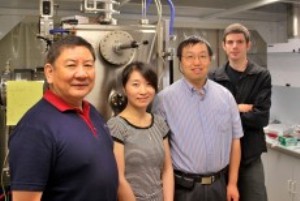Researchers at the University of Georgia have devised a single-step, quick and accurate technique using nanomaterials to detect pathogens and contaminants. The team demonstrated the capability of the new technique in detecting compounds like protein albumin and lactic acid in extremely diluted mixtures that comprised of dyes and chemicals.

University of Georgia researchers, left to right, Yao-Wen Huang, Jing Chen, Yiping Zhao and Justin Abell stand in front of an electron beam evaporator at the UGA Nanoscale Science and Engineering Center
The researchers conclude that the same method can be employed on biological mixtures like blood, saliva, food and urine to detect contaminants and pathogens.
The new diagnostic method is derived from two well established techniques combined by incorporating nanotechnology. The first known technique adopted is the surface enhanced Raman spectroscopy or SERS which measures the frequency change of a laser beam as it scatters off a compound. The shift in frequency triggered by each compound is unique and is referred to as the Raman shift. Though this method could help to identify compounds, the signal produced is weak. The researchers used an array of silver nano rods placed at a particular angle to amplify the signals. The same method has been already used at UGA to isolate RSV and HIV from infected cells.
The second part to the diagnostic process involves the separation of biological agents present in blood, saliva and urine that interfere with detection. Conventional technique of thin layer chromatography or TLC involves blotting a porous surface with a drop of the sample to which a solvent like methanol is then added. Based on the attraction towards surface and solvent, the sample components disintegrate. Typically, large sample volume is necessary for carrying out TLC. However, the use of silver nano rod surface enables the final diagnostic with just a miniscule amount of sample giving rise to a new technique labeled as ultra thin layer chromatography. The method can yield results in less than an hour even for samples with concentrations diluted below 182 nanograms per milliliter. This is far better than traditional virus detection techniques such as polymerase chain reaction that takes days to weeks and requires the use of fluorescent labels.
Disclaimer: The views expressed here are those of the author expressed in their private capacity and do not necessarily represent the views of AZoM.com Limited T/A AZoNetwork the owner and operator of this website. This disclaimer forms part of the Terms and conditions of use of this website.